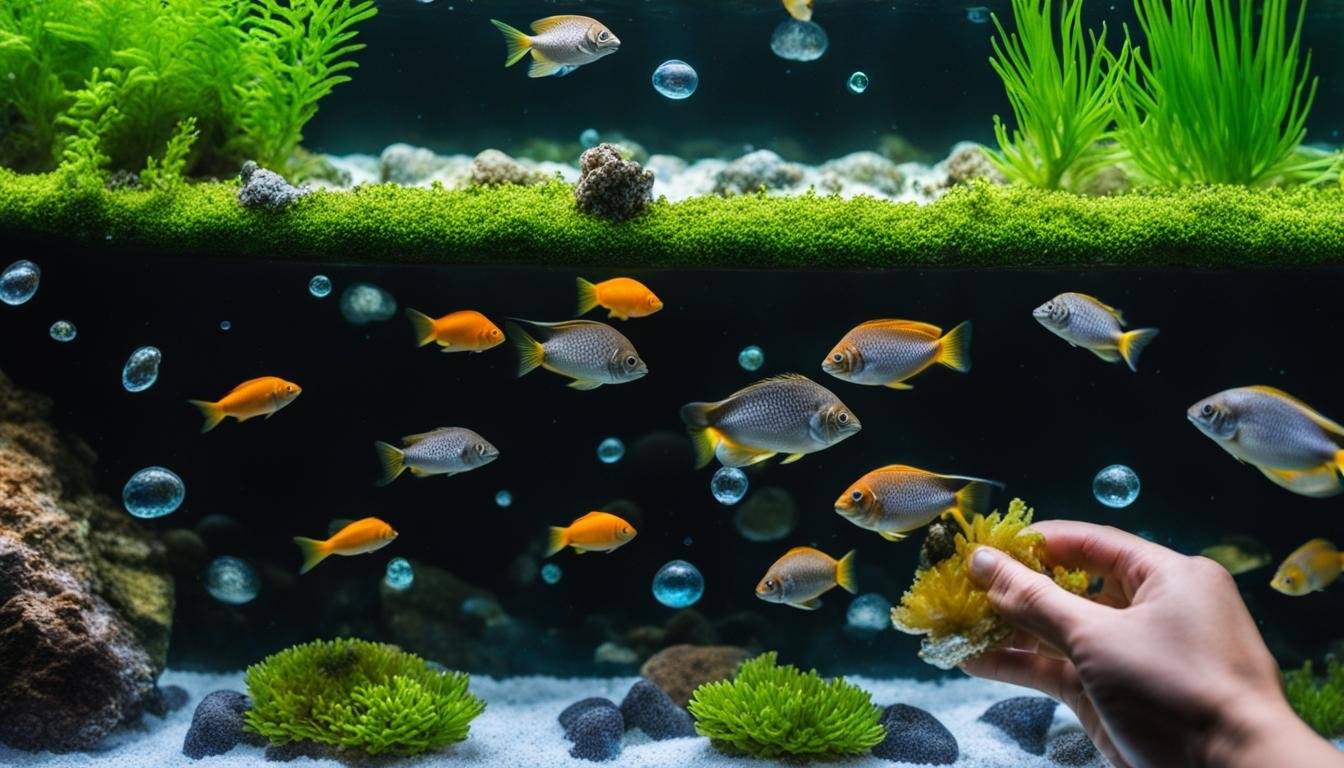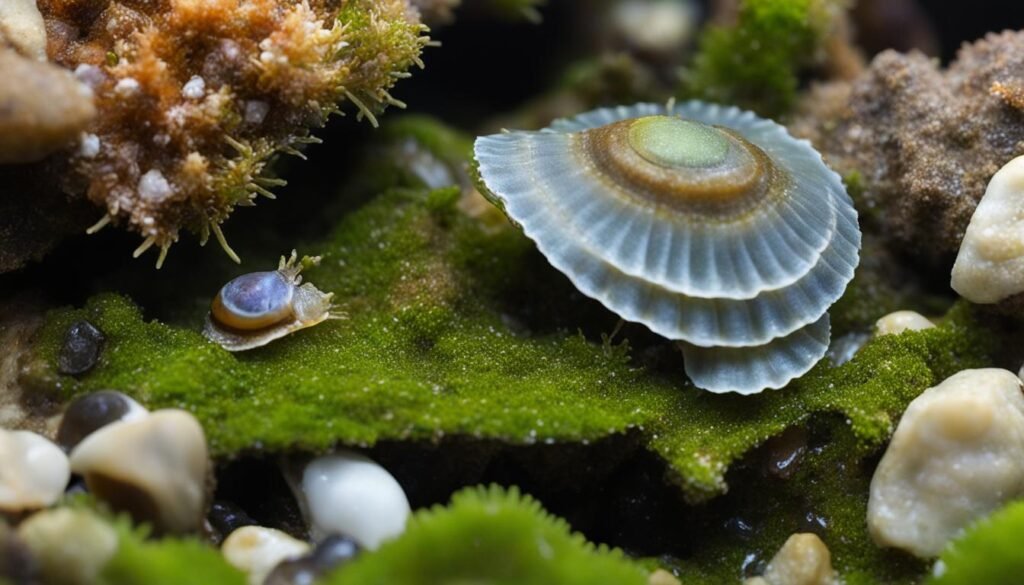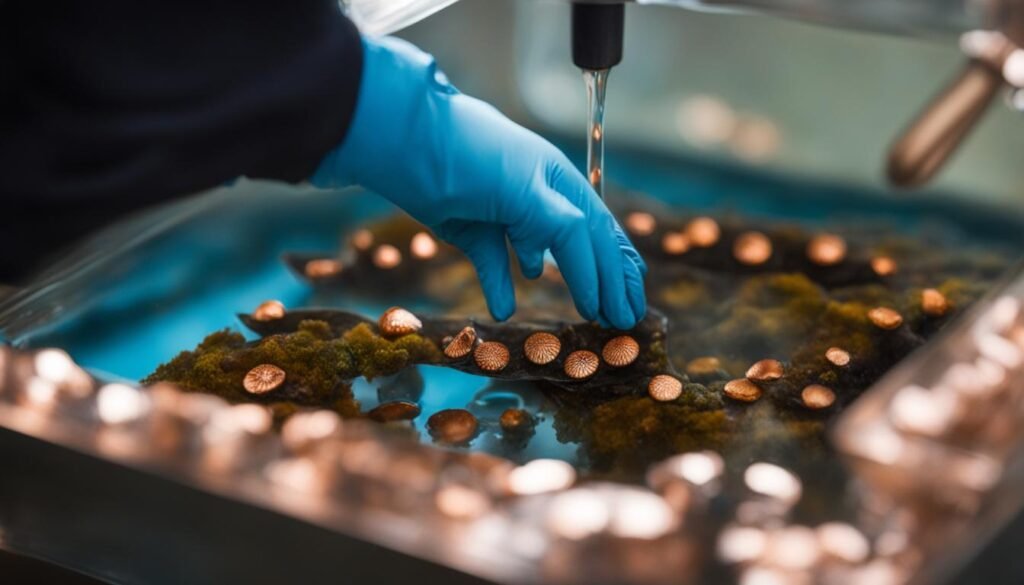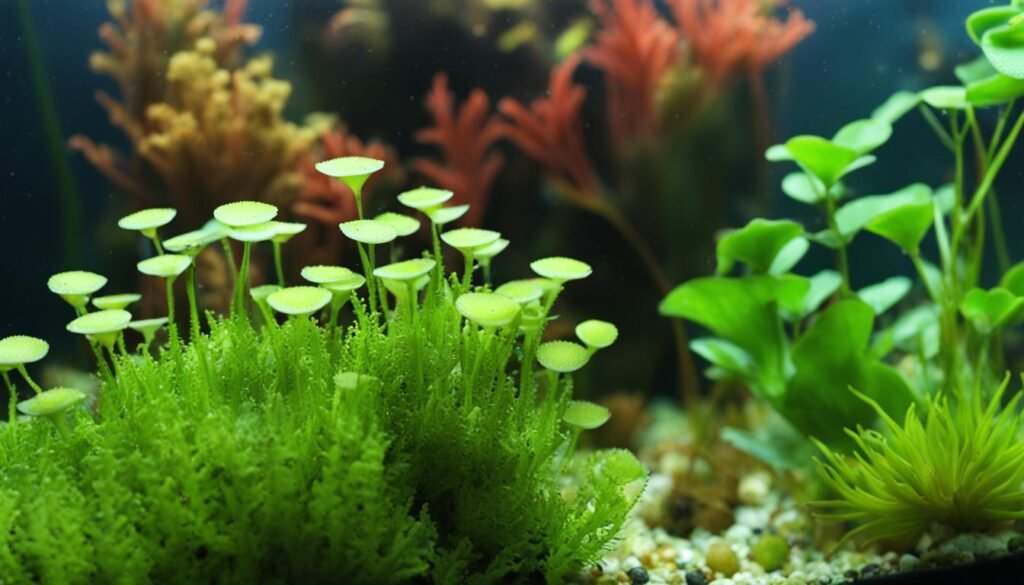Your cart is currently empty!

How To Get Rid Of Limpets In Aquarium?
Welcome to our comprehensive guide on how to effectively control limpets in your aquarium and prevent pesky infestations. Limpets can become a nuisance when their population increases, but fear not, because we have gathered the best techniques and tips to help you maintain a limpet-free aquarium. Let’s dive in!
Key Takeaways:
- Preventing limpet infestations is key to maintaining a clean and healthy aquarium.
- Quarantine new plants and disinfect aquarium decorations to reduce the risk of introducing limpets.
- Natural methods, such as manual removal and introducing limpet predators, can help control limpet populations.
- In severe cases, chemical treatments can be used as a last resort, but caution must be taken to avoid harming other aquatic inhabitants.
- Regular maintenance practices and maintaining a balanced ecosystem are crucial in managing and controlling limpets.
Understanding the Nature of Limpets
Limpets are fascinating creatures that can inhabit aquariums, adding diversity to the underwater ecosystem. These gastropods are often mistaken for snails due to their similar appearance. However, they have unique characteristics and behavior that set them apart.
Limpet Behavior
- Limpets are known for their ability to adhere to surfaces using a muscular foot, allowing them to withstand strong water currents in the aquarium.
- They have a grazing habit and primarily feed on algae, which can be beneficial for keeping the tank clean and free of excessive algae growth.
- Limpets prefer to inhabit hard surfaces like rocks, glass, or substrate, where they can find a stable footing.
Limpet Characteristics
- Limpets have a conical or shield-shaped shell that protects their soft bodies. The color of their shells may vary, ranging from light brown to darker shades.
- They possess a rasping radula, a specialized organ used to scrape algae from surfaces.
- Limpets are hermaphrodites, meaning they have both male and female reproductive organs.
Understanding the behavior and characteristics of limpets can help aquarium owners make informed decisions about managing their populations. While limpets may become unsightly when their numbers increase, it is essential to strike a balance that allows these fascinating creatures to contribute to the overall health of the aquarium ecosystem.
Tips for Preventing Limpet Infestations

Preventing limpet infestations in your aquarium is crucial for maintaining a healthy and thriving aquatic ecosystem. By implementing a few preventive measures, you can significantly reduce the risk of introducing limpets into your tank. Here are some tips to consider:
Quarantine New Plants
Before adding any new plants to your aquarium, it’s essential to quarantine them separately for a period of time. This allows you to closely monitor the plants for any signs of limpets or other unwanted pests. During the quarantine period, inspect the plants regularly and observe them for any signs of limpet infestation. This precautionary step helps ensure that your aquarium remains free from potential limpet introductions.
Disinfect Aquarium Decorations
Aquarium decorations, such as rocks, driftwood, and ornaments, can harbor limpet eggs or larvae. Before adding these decorations to your tank, it’s important to disinfect them thoroughly. You can do this by soaking the decorations in a diluted bleach solution or by using an aquarium-safe disinfectant. Be sure to rinse the decorations thoroughly after disinfection to remove any traces of the chemical. This process helps eliminate any existing limpet eggs or larvae, reducing the risk of infestation in your aquarium.
Maintain Proper Aquarium Maintenance
Regular aquarium maintenance plays a vital role in preventing limpet infestations. Keep your tank clean by removing any debris, uneaten food, or decaying organic matter. Limpets thrive in environments with excessive algae growth, so it’s essential to control algae levels in your tank. Consider implementing measures such as regular water changes, careful feeding practices, and the use of algae-control methods to maintain optimal water conditions for your aquarium inhabitants. By creating a clean and balanced environment, you can discourage limpets from taking hold in your aquarium.
- Quarantine new plants to monitor for limpets before adding them to your tank.
- Disinfect aquarium decorations to eliminate any limpet eggs or larvae.
- Regularly clean your tank and control algae growth to discourage limpets from infesting your aquarium.
Natural Ways to Eliminate Limpets

When it comes to dealing with limpets in your aquarium, you don’t always have to resort to chemical treatments. There are natural methods that can effectively eliminate these unwanted pests. Here are some techniques you can try:
1. Manual Removal of Limpets
One of the simplest and most effective ways to control limpet populations is to manually remove them from your aquarium. This can be done by carefully scraping them off the surfaces using a soft brush or a credit card. Be sure to remove both the limpet itself and its attached shell to prevent further infestations.
2. Introducing Limpet Predators
Another natural approach is to introduce limpet predators into your aquarium. Certain fish and snail species, such as some varieties of wrasses and puffers, feed on limpets and can help control their numbers. However, it’s important to research and choose compatible species that won’t harm your other tank inhabitants.
By using these natural methods, you can effectively manage and reduce limpet populations in your aquarium without the need for chemical treatments. However, it’s important to regularly monitor your tank and take prompt action if you notice any limpet infestations to prevent them from multiplying and causing further damage.
Using Chemical Treatments to Remove Limpets

If you’re dealing with a severe limpet infestation in your aquarium, chemical treatments can be an effective solution. One popular option is using copper-based treatments specifically designed to target and eliminate limpets. These treatments work by disrupting the shell development and overall physiology of the limpets, leading to their eventual demise.
When using chemical treatments, it’s important to carefully follow the instructions provided by the product manufacturer. This will ensure that you apply the treatment correctly and avoid any potential harm to other aquarium inhabitants. Overdosing can be detrimental to the overall health of your aquarium, so it’s crucial to follow the recommended dosage and treatment duration.
Benefits of Copper-Based Treatments:
- Copper-based treatments are highly effective in targeting and eliminating limpets
- They are relatively easy to use and readily available in most pet stores
- These treatments do not harm most aquarium plants and other invertebrates
Considerations:
- Copper-based treatments can be harmful to certain species of fish and invertebrates, so it’s important to research the compatibility of your aquarium inhabitants before using these treatments
- Monitor your aquarium closely during and after treatment to ensure that the limpets are being successfully eliminated and that your other aquarium inhabitants are not experiencing any adverse effects
Remember, chemical treatments should always be used as a last resort and only when necessary. It’s best to try natural methods and preventive measures first to maintain a healthy and limpet-free aquarium.
Managing Limpets in Fish Tanks

When it comes to managing limpets in fish tanks, our goal is to ensure a balanced aquarium ecosystem while controlling their population. Here are some tips and techniques to help you maintain a limpet-free environment.
Regular Maintenance
Keeping up with regular tank maintenance is crucial in managing limpets. Regularly clean the tank by removing any debris or excess food that could contribute to their growth. Additionally, pay attention to water quality and ensure proper filtration and oxygenation. These measures create an unfavorable environment for limpets to thrive.
Controlling Algae Growth
Limpets are attracted to algae, so controlling its growth is an effective way to manage their population. Consider implementing strategies to keep algae growth in check, such as adjusting lighting and nutrient levels, using algae-eating fish or snails, or manually removing excess algae. By limiting their food source, you can limit limpet numbers.
Targeted Limpet Removal
If limpet numbers start to increase, manual removal can be an effective method. Carefully inspect the tank and remove any visible limpets using a soft sponge or scraper. This targeted approach helps keep their population in check without causing harm to other tank inhabitants.
By following these strategies and maintaining an attentive approach, you can effectively manage limpets in your fish tank. Remember, complete eradication may not be necessary or advisable, as limpets can contribute to the overall health of the tank. It’s all about striking a balance between population control and a thriving aquarium ecosystem.
Strategies for Dealing with Limpets in Shrimp Tanks

Limpets in shrimp tanks can pose a challenge as they have the potential to compete for resources and disrupt the delicate balance of the tank. However, with a few strategic measures, you can effectively manage limpet populations without causing harm to your shrimp. Here are some strategies to consider:
1. Manual Removal
Regular manual removal of limpets can help keep their numbers in check. Carefully inspect the tank and remove any visible limpets by gently scraping them off the surfaces using a soft brush or scraper. Be cautious not to disturb the shrimp or damage any delicate plants or decorations.
2. Introducing Limpet Predators
Introducing natural limpet predators can be an effective way to control their population. Certain fish species, such as pygmy corydoras or otocinclus catfish, are known to feed on limpets. Additionally, small snail species like assassin snails can also help in keeping limpet numbers under control. However, it’s important to research the specific compatibility of these species with your shrimp to ensure they won’t cause any harm.
3. Maintaining Optimal Water Conditions
Providing optimal water conditions for your shrimp can help create an environment that is less favorable for limpets. Shrimp thrive in clean, well-maintained tanks with stable water parameters. Regular water changes, filtration, and avoiding overfeeding can help maintain water quality and discourage limpet infestations.
By implementing these strategies, you can actively manage limpet populations in your shrimp tank, ensuring a healthy and thriving environment for your shrimp while minimizing the negative impact of limpets.
Effective Techniques for Controlling Limpets in Planted Aquariums

Planted aquariums provide a beautiful and natural environment for aquatic plants and fish. However, dealing with limpets in these tanks can be challenging. Limpets, while beneficial in controlling algae, can become problematic when their population grows unchecked. To maintain a healthy and balanced ecosystem in your planted aquarium, here are some effective techniques for controlling limpets.
1. Regular Maintenance
Regular maintenance is key to preventing limpets from becoming a nuisance in your planted aquarium. This includes removing any decaying plant matter or dead fish, as these can attract limpets. Additionally, frequent water changes and vacuuming the substrate help in controlling the overall nutrient levels, which can influence limpet populations.
2. Optimal Water Parameters
Maintaining optimal water parameters in your planted aquarium can aid in controlling limpets. Limpets thrive in environments with excessive nutrients, so ensuring proper filtration and water circulation can help minimize their numbers. It is also important to monitor and adjust the lighting conditions, as excessive light can promote algae growth, which is a food source for limpets.
3. A Balanced Ecosystem
Creating a balanced ecosystem in your planted aquarium can contribute to the control of limpets. Introducing compatible aquatic species that feed on limpets, such as certain snail species, can help manage their population. However, it is important to research and choose these species carefully to avoid introducing invasive species or predators that may harm other tank inhabitants.
By implementing these techniques, you can effectively control limpets in your planted aquarium and maintain a healthy and thriving aquatic environment.
Conclusion
In conclusion, managing limpets in your aquarium requires a proactive approach to prevent infestations and maintain a limpet-free environment. By following these limpet management tips, you can ensure the health and aesthetic enjoyment of your aquatic habitat.
To maintain a limpet-free aquarium, it is important to take preventive measures such as quarantining new plants and disinfecting aquarium decorations. Regular maintenance practices like cleaning the tank and controlling algae growth also play a crucial role in preventing limpet infestations.
If you do find yourself dealing with a limpet population, there are natural as well as chemical methods for removing them. Manual removal through traps or by hand can be effective, while introducing limpet predators can provide a natural control solution. In severe cases, chemical treatments can be used as a last resort, but caution must be exercised to protect other aquarium inhabitants.
Remember, the goal is not necessarily to completely eradicate limpets, as they can contribute to the overall health of your aquarium. Instead, focus on maintaining a balance between their populations and the well-being of your tank. With these techniques, you can enjoy a limpet-free aquarium and create a thriving aquatic ecosystem.
FAQ
How can I prevent limpets from entering my aquarium?
To prevent limpets from entering your aquarium, you can quarantine new plants and disinfect aquarium decorations. Regular maintenance practices, such as cleaning and controlling algae growth, also help in preventing limpet infestations.
What are some natural methods for removing limpets from my aquarium?
Manual removal, using traps or by hand, can be effective in managing limpet populations. Introducing limpet predators, such as certain fish or snail species, can also help control their numbers.
Are there chemical treatments available for removing limpets?
In severe cases of limpet infestations, chemical treatments can be used as a last resort. Copper-based treatments have been effective in eliminating limpets, but it is important to carefully follow product instructions to avoid harming other aquarium inhabitants.
How can I manage limpets in fish tanks without harming other aquarium inhabitants?
Regular maintenance practices, such as cleaning the tank and controlling algae growth, can help in controlling limpet numbers. It is important to understand that completely eradicating limpets may not be necessary or even advisable, as they can contribute to the overall health of the tank.
How can I deal with limpets in shrimp tanks?
Certain strategies can be employed to manage limpet populations in shrimp tanks without harming the shrimp. This may include manual removal, introducing limpet predators, and maintaining optimal water conditions for shrimp health.
What techniques can I use to control limpets in planted aquariums?
Regular maintenance, proper water parameters, and maintaining a balanced ecosystem can help in controlling limpet populations in planted aquariums. It is important to consider the impact of any treatment methods on the plants and other tank inhabitants.
Leave a Reply